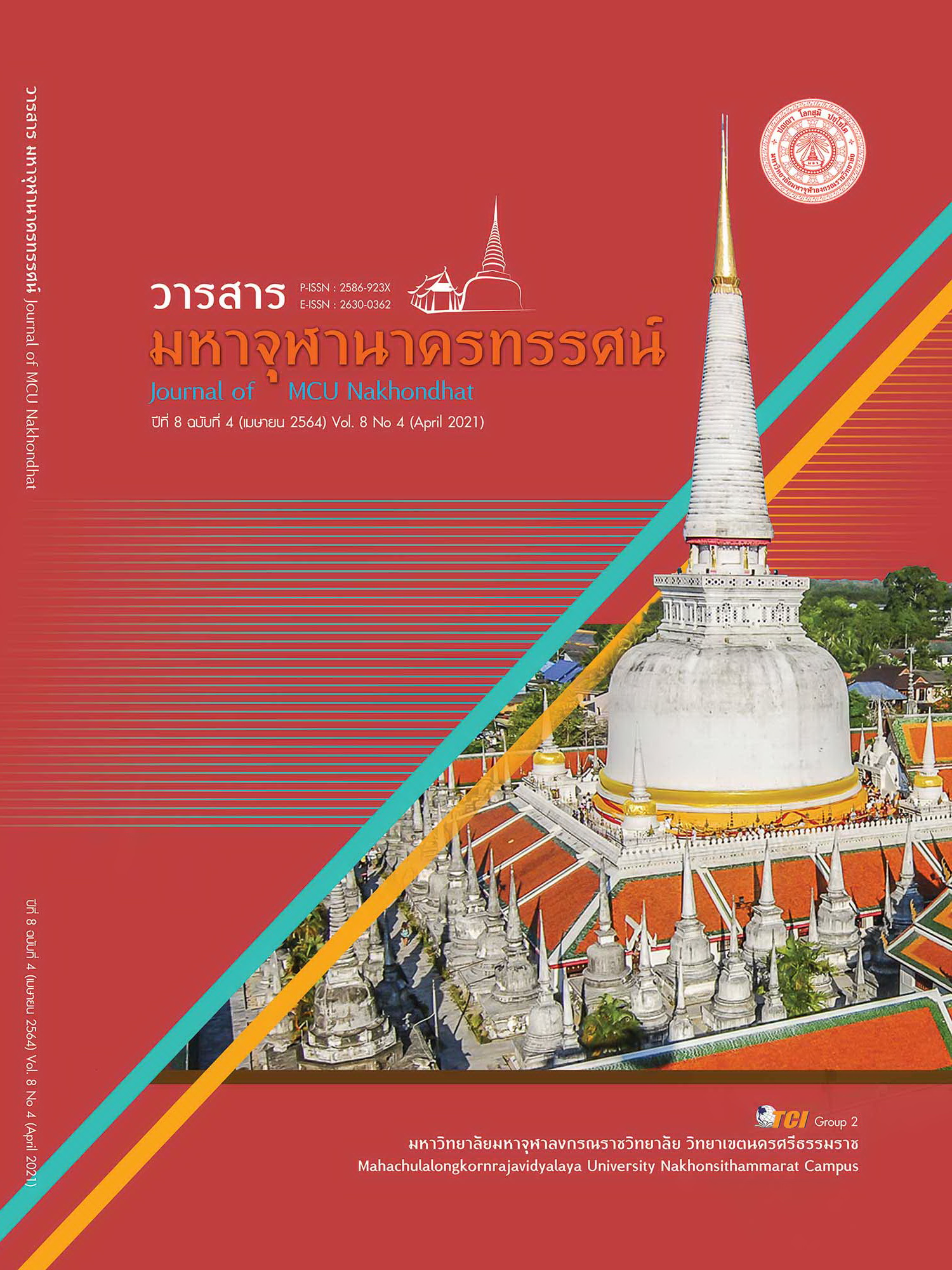AN APPICATION OF THE AYUSSA - DHAMMA IN THE LIFE STYLE OF AGED PERSONS IN THE AREA OF KUDJAP DISTRICT, UDORN THANI PROVINCE
Main Article Content
Abstract
The objectives of this research article were to: 1) the problem situation of the elderly in the area of Kutjap District, Udonthani Province 2) the Ayussadhamma principle for the elderlys’ lives in the area of Kutjap District, Udonthani Province and 3) the guideline of applying the Ayussadhamma Principle for the elders’ lives in the area of Kutjap District, Udonthani Province. This research was the qualitative research by studying the documents and interview. The results of this research were found that the elderlies were 60 years old up and their physical condition was declined and emotion was confused, not to be self - confidence and afraid of various perils, denouncement of family, descendants, society and community was important for the elderly and the nation. The elderlies’ importance was that they were persons who had more experiences in various forms both good and bad and they were the refuge of descendants and taught the local wisdom for their descendants continuously. The problem situation for the elderly’s lives in the area of Kutjap District was found that the physical aspect of the elderly depended on the physical declination. The Ayussadhamma principles 1) Sappayakari means to do what is suitable for oneself and favorable for one’s health 2) Sappaye mattannu means to be moderate even as to things suitable and favorable 3) Parinatabhoji means to eat food which is ripe and easy to digest 4) Kalacari means to behave oneself properly as regards time and spending of time and 5) Brahmcari means to know the suitable Brahmacari. The elderlies had the spiritual and emotional problems and to have the guideline for preserving the good health as the total in the four aspects, that is, the physical, social, spiritual, and intelligent aspect respectively.
Article Details
References
จุฑาทิพย์ อภิรมย์. (2537). ข้อเท็จจริงและทัศนะการเข้าร่วมกิจกรรมเพื่อสังคมของผู้สูงอายุ: กรณีศึกษาชุมชนเทศบาลเมืองนครราชสีมา. จังหวัดนครราชสีมา: มหาวิทยาลัยธรรมศาสตร์.
ทิพย์วดี เหลืองกระจ่าง. (2550). การพัฒนารูปแบบการเรียนรู้ตามแนวพุทธศาสตร์เพื่อพัฒนาผู้สูงอายุ. ใน ดุษฎีนิพนธ์ครุศาสตรดุษฎีบัณฑิต สาขาวิชาพัฒนการสอน. จุฬาลงกรณ์มหาวิทยาลัย.
ธาริน สุขอนันต์ และคณะ. (2554). คุณภาพชีวิตของผู้สูงอายุ. วารสารสาธารณสุขศาสตร์วิทยาลัยการสาธารณสุขสิรินธร จังหวัดชลบุรี, 41(3), 240-249.
บรรลุ ศิริพานิช. (2553). คู่มือการดูแลตนเองของผู้สูงอายุ สร้างใจให้แข็งแรง. กรุงเทพมหานคร: พิมพ์ดี.
พระบุญทรง หมีดา (ปุญฺญธโร). (2549). ปัญหาและทางออกของผู้สูงอายุตามหลักพระพุทธศาสนา. จังหวัดเชียงใหม่: มหาวิทยาลัยเชียงใหม่.
พระพรหมคุณาภรณ์ (ป.อ. ปยุตฺโต). (2544). พุทธธรม ฉบับเดิม. กรุงเทพมหานคร: ธรรมสภา.
พระพรหมคุณาภรณ์ (ป.อ. ปยุตฺโต). (2550). สร้างวาสนา - เพิ่มค่าให้อายุ. กรุงเทพมหานคร: พิมพ์สวย.
พระมหาทวี มหาปญฺโญ (ละลง). (2556). วิเคราะห์อายุสสธรรม 5 หลักธรรมที่ช่วยให้อายุยืน 5 ประการในคัมภีร์พระพุทธศาสนาเถรวาท. เรียกใช้เมื่อ 8 มกราคม 2564 จาก https://www.mcu.ac.th/article/detail/281
รุจิรางค์ แอกทอง. (2549). การปรับตัวของผู้สูงอายุในเขตเทศบาลนครปฐม จังหวัดนครปฐม. ใน วิทยานิพนธ์ศิลปศาสตรมหาบัณฑิต สาขาวิชาจิตวิทยาชุมชน. มหาวิทยาลัยศิลปากร.
วิไลวรรณ อาจาริยานนท์. (2554). การศึกษาความสอดคล้องระหว่างการเสริมสร้างสุขภาพเชิงพุทธกับการเสริมสร้างสุขภาพของผู้มีอายุยืนในสังคมไทย. กรุงเทพมหานคร: มหาวิทยาลัยจุฬาลงกรณราชวิทยาลัย.
สุรางค์ โคว้ตระกูล. (2536). ปัญหาผู้สูงอายุ. กรุงเทพมหานคร : สภาสังคมสงเคราะห์แห่งประเทศไทยในพระบรมราชูปถัมภ์.
อำไพขนิษฐา สมานวงศ์ไทย. (2558). ปัญหาผู้สูงอายุ 3 ด้าน. เรียกใช้เมื่อ 8 มกราคม 2564 จาก http://suwanna12.blogspot.com/2012/07/blog-post.html


